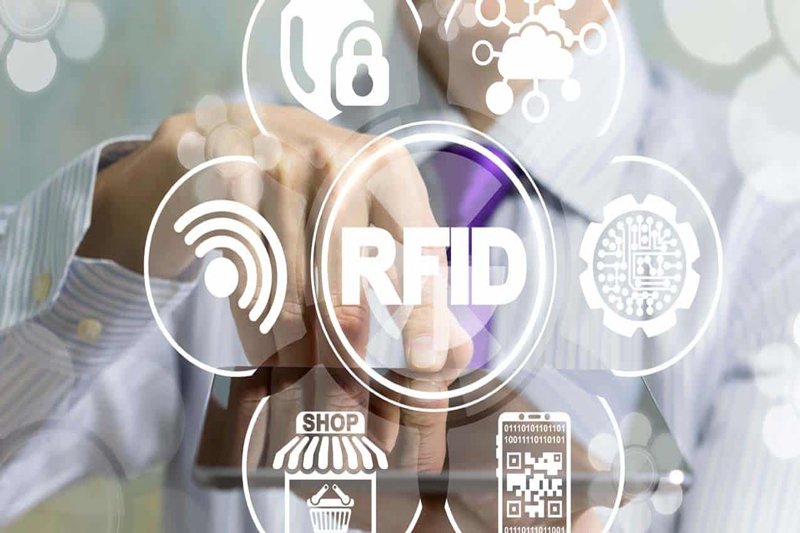Guide To Choosing RFID Types And How To Use Them – Radio Wave Detection System And Its Applications
Radio Frequency Identification (RFID) Radio Frequency Identification Is A Wireless Detection And Tracking Technology That Exchanges Information Between Labels Attached To A Product And A Reader.
These tags contain information that is stored electronically. Passive tags receive the energy they need from the radio waves emitted by the RFID receiver. In contrast, active tags have an internal power supply (such as a battery) and can operate hundreds of meters away from the RFID receiver.
Unlike barcodes, labels do not need to be directly visible to the recipient to be embedded in the products to be tracked. RFID is one of the mechanisms for automatic detection and reception of data (AIDC).
Guide to choosing RFID types and how to use them
RFID tags are used in various industries. For example, an RFID tag can be attached to a vehicle under construction to track its manufacturing progress on the production line, or drugs with an RFID tag can track in various warehouses.
In general, AIDC is a method by which equipment, whether hardware or software, can read and recognize data without the human factor. RFID systems use electronic and electromagnetic signals to read and write data without contact. Commonly, any system that can read and identify information about people or goods is called an Identification System.
radio waves
The electromagnetic spectrum consists of different types of wave frequencies that are generated using electromagnetic energy. A radio wave is a disturbance in space that transmits power from one place to another. Radio waves are constantly oscillating so that the point is continuously increasing and decreasing as it moves.
This oscillation is typically represented as a wave pattern consisting of peaks (highest) and valleys (lowest level). The path traveled between the valleys, and the mountains are considered a complete wave cycle.
Radio waves are detected based on frequency and wavelength. The number of cycles that occur per second is also known as the rate of wave oscillation. The unit of measurement is the frequency of hertz, and one hertz equals one complete wave cycle per second, so the frequency depends on the speed of the wave oscillation.
Wavelength
In the RF spectrum radio subset, there are eight distinct frequency bands:
- Shallow frequency
- Low frequency
- Medium frequency
- High Frequency
- Very high frequency
- Higher frequency
- Ultra-high frequency
- Extremely high frequency
The wavelength gradually decreases, starting from the left side of the spectrum to the right. Very Low Frequency (VLF) is the first frequency on the left side of the spectrum, with an average wavelength of about 55,000 meters. In other words, the average distance of a VLF wave from one peak to the next (or from one valley to the next) is 55,000 meters.
Because radio wavelengths are related to data transfer speeds (i.e., the longer the wavelength, the slower the data transfer rate, and vice versa), the data transfer rate on VLF waves is meager. Therefore, VLF is not usually used for RFID applications. . Of the eight frequencies on the radio band, there are three frequencies commonly used for RFID applications:
- Low frequency (LF)
- High frequency (HF)
- High frequency (UHF)
Low frequency
- Low frequency (LF band) is between 30 kHz to 300 kHz with wavelengths of about 2400 meters. Because different types of signals communicate with each other in this band, LF RFID systems are only allowed to use the small range of 125-134 kHz. Large wave size causes LF waves to penetrate metal and water, unique to this frequency band (Figure below).

- Although LF RFID has a long wavelength, its data reading range is shorter than HF and UHF RFID. This distance is only a few centimeters to about 50 centimeters in ideal conditions. This short reading range is due to the dependence on magnetic coupling. LF tags are usually more expensive than HF and UHF RFID tags, but the price difference depends on the type and uses. Usually, each label costs between $ 0.70 and $ 20. These tags come in various shapes and sizes, but they all use the same type of magnetic coupling for power and communication. Also, these tags have a relatively low read speed because the data exchange rate is meager, and the receiving device needs more time to receive and decode the tag signal.
- Depending on the type of consumption, a combination of LF antenna and RFID receiver is available and will usually cost between one hundred and one thousand dollars. Unlike other RFID tags, LF tags do not have a specific security standard, so their use is not recommended for applications where encrypted communications are essential.
Uses
- LF RFID systems are often used for tracking purposes, especially for animals, because reading LF tag information is easy. However, they are also used in access control applications (Figure below).

High Frequency
- The high-frequency band (HF) extends from 3 MHz to 30 MHz in the radio frequency range. The wavelength of the high-frequency waves is much shorter than the LF wave and only about 22 meters (slightly less than the length of 2 school buses). High frequency uses magnetic coupling to communicate between the tags and the receiver. HF waves pass through all materials except water and dense metals (Figure below).
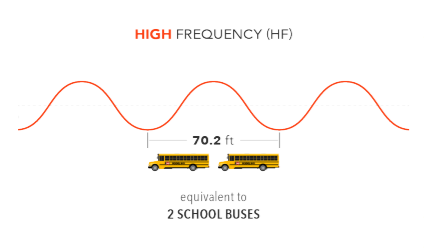
- HF RFID tags usually have a reading range of a few centimeters to about one meter, depending on the system settings. The RF spectrum mainly uses Near Field Communication (NFC) technology in the high-frequency band, a communication protocol approved by the International Organization for Standardization. Since NFC is a global communication standard, it operates on a single frequency (13.56 MHz). For this reason, NFC is used for a variety of applications. NFC and HF tags are inexpensive and cost between $ 0.35 and $ 10, depending on the size and structure.
Uses
- Various companies are looking for HF and NFC RFID to meet their business needs using RFID technology. NFC is especially useful in marketing applications such as advertising posters, intelligent items, and brand/item interactive experiences. The most common uses of HF RFID are for access control, data transfer, and ticket sales. HF RFID tags are also used in some countries’ passports, such as the United States, Norway, Japan, Australia, India, etc. There were criticisms about the security of these labels in tickets in the past. Still, later, the problem solves by adding a metal cover to reduce the reading range and the password that must enter into the RFID receiver to read the label (Figure below).
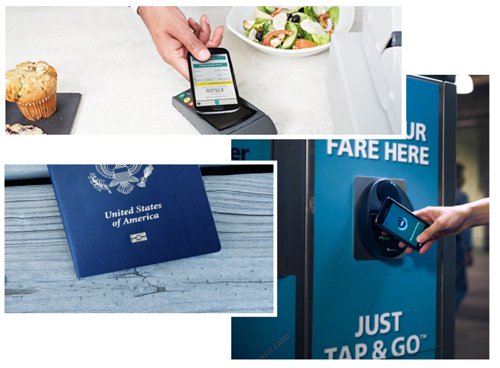
Higher frequency
- The high-frequency band in the radio frequency range is 300 MHz to 3 GHz, but most UHF RFID systems operate in bands between 860 and 960 MHz, except for some RFID systems that use the 433 MHz 2.45 GHz bands (Figure below).
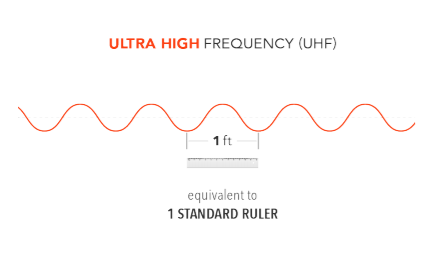
- UHF waves have an average length of about 33 cm, but at higher frequencies such as 2.45 GHz, this length decreases to 12 cm. UHF RFID is usually implemented in two types: Passive and Active.
Passive UHF RFID
- Passive UHF RFID tags are dependent on a passive transmitter source (backscatter) for working to modulate electromagnetic energy distribution and return it and have no additional power supply. In other words, the RFID receiver sends its energy in the form of RF waves through the antenna to the UHF RFID tags, and the tags respond to the receiver after receiving the point. This response is called electromagnetic energy scattering because the label returns part of the energy received from the receiver. Since there is no additional power supply in this system, the maximum distance between sending and receiving data is about 30 meters. Passive UHF RFID tags are inexpensive due to their widespread use, with an average price of $ 0.10 per tag.
Uses
Passive UHF RFID systems include hundreds of applications, including path tracking, product tracking, etc. Due to the low cost and convenient coverage of sending and receiving data, this technology is used in various forms in the industry (Figure below).

Active UHF RFID
- Active UHF RFID systems do not need to work to distribute electromagnetic energy and return it to the passive transmitter source (backscatter); instead, they use an internal battery as the power supply and therefore do not need to receive power through the receiver. Due to battery power, Active UHF RFID tags can cover more than 100 meters. Some active RFID tags are designed to operate in harsh environments, such as shallow temperatures. Active RFID tags are relatively expensive due to their more sophisticated electronic equipment. Based on their capabilities (such as Wi-Fi, Bluetooth, GPS), they are priced at around $ 20 per tag.
Uses
- Active UHF RFID technology is often used in heavy industries such as oil and gas, transportation, and vehicle tracking. Due to the technology used in these labels, reading information while moving is easy and, therefore, a good option for tracking containers and vehicles. Another everyday use is for active RFIDs in piping and construction equipment (Figure below).
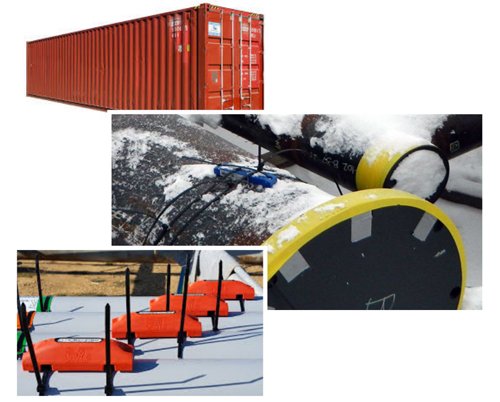
Software compatibility
- Analyzing and evaluating the information on RFID tags by application software is an important issue. The data collected and processed to be used carefully processing by the software in areas such as supply chain or more precise process planning. Communication experts believe that the widespread use of RFID tags can create vast volumes of data in the production and supply chain that will explode the collected information, making it difficult for advanced systems to process. Be. For this reason, algorithms are needed to gather information intelligently and compactly to process information faster.










